Receive free Uber Technologies Inc updates
We’ll send you a myFT Daily Digest email rounding up the latest Uber Technologies Inc news every morning.
If you were looking for a sign that the tech start-up world has shaken off the growth-at-all-costs mindset that typified the last decade, Uber reporting a profit this week for the first time might fit the bill.
The US ride-hailing company was emblematic of Silicon Valley’s ugly side during the boom years of the 2010s. It gave a whole new meaning to the phrase “cash burn”, reporting more than $30bn of operating losses as it took advantage of a ready supply of cheap capital to subsidise a global growth spree.
The chronic losses left doubts about whether the economics of ride-hailing — as well as the food delivery business Uber also moved into — would ever make sense, or whether companies would be able to build competitive moats in these markets.
It wasn’t only a case of financial transgression. For Uber, trampling on regulations and antagonising the taxi-drivers it wanted to replace was a feature, not a bug.
It is almost two years since the stock market turned sour on high-growth tech companies, a reversal that quickly fed through into private markets and stemmed the flow of capital. But how much has really changed?
These days, company founders speak a different language and consciously adopt a less abrasive demeanour. They like to talk about how their companies will be financially sustainable and socially responsible. These look like necessary stylistic adaptations to the times. But the incentive structure of the venture capital world hasn’t changed: outsized rewards still go to the biggest winners in new markets. Nor have cycles in the capital markets been banished.
Uber’s early years were an extreme version of the expansionism that took hold during the period of ultra-low interest rates following the 2008-2009 financial crisis. So much money was being tossed about that we ended up with disasters such as WeWork and Theranos.
Uber embodied an extreme version of a prevalent business model and culture. Other internet companies might have been prepared to bend regulations in the race for global growth, but few were as willing to openly flout them.
With Uber, the question was always: what would happen when the cheap money ran out and regulators finally caught up with the company? Did it provide enough real value to riders and drivers — and, more recently, users of its delivery services — to justify the unprecedented accumulated losses it was amassing?
By squeezing out the company’s first operating profit this quarter, Dara Khosrowshahi, the former Expedia boss who took over six years ago, and Nelson Chai, who came in as chief financial officer to steer the company’s initial public offering and its aftermath, have provided at least a partial answer.
As capital has become more expensive and competition has waned, the subsidised rides and deliveries that drove Uber’s growth have largely ended. Pushing less well capitalised rivals to the sidelines before raising prices was always at the heart of the plan championed by Uber’s early backers — though they probably didn’t think it would take 14 years to get to this point.
Despite the higher prices, bookings have continued to rise steadily. It is a good sign that riders and eaters see value in the convenience of ordering through Uber’s app and were not only drawn by uneconomically low charges.
Uber is also starting to flex its muscles as a platform, as it looks for ways to encourage the 137mn people who use its services at least once a month to become more regular customers. It has a subscription service, Uber One, and cross-promotes its different services. Advertising is starting to become an important source of revenue.
The unresolved question is whether this will be enough both to make Uber sustainably profitable and to support the kind of margins that would justify the huge upfront investments it took to build the company. But if it has really turned a corner then, ironically, it will have partly validated the aggressive tactics that set the company on its way.
It would be comforting to think that regulators had learnt the lessons from the last decade of tech growth. But as another tech race heats up, this time in artificial intelligence, they are once again struggling to adapt quickly enough. The leading AI companies have promised to apply this powerful new technology responsibly. The huge rewards at stake — and the capital flooding into lossmaking AI start-ups — will put that to the test.
Read the full article here



